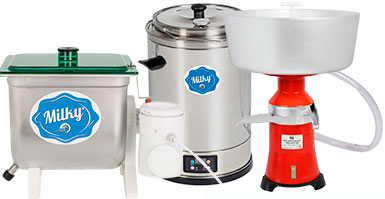Do you think you might be lactose intolerant? Maybe you saw your doctor, told them about your symptoms and they concluded that you are.
Either way, you now need to live a bit differently. With that said, you don’t have to refuse every single dairy-based product you encounter. Cheese and ice cream can still be on the menu. You just need to make some tweaks.
Let’s dive into all the things you need to know about lactose intolerance and the ways you can manage it.
What is lactose intolerance?
First of all, it’s not a true allergy. Dairy products don’t trigger your immune system like allergens do. If you’re lactose intolerant, it means that your body doesn’t produce enough lactase or produces none at all.
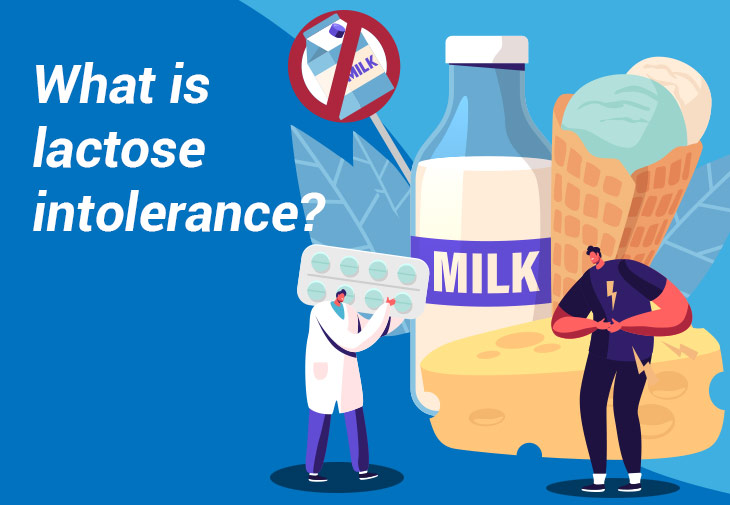
Lactase is an enzyme that digests lactose—the carbohydrate that milk and other dairy products contain. If you don’t have enough lactase, any lactose you consume starts the fermentation process in the intestines that causes all the irritating symptoms of lactose intolerance.
What are the symptoms of lactose intolerance?
The most common symptoms of lactose intolerance are:
- Diarrhea
- Nausea
- Abdominal cramps
- Bloating
- Excessive gas
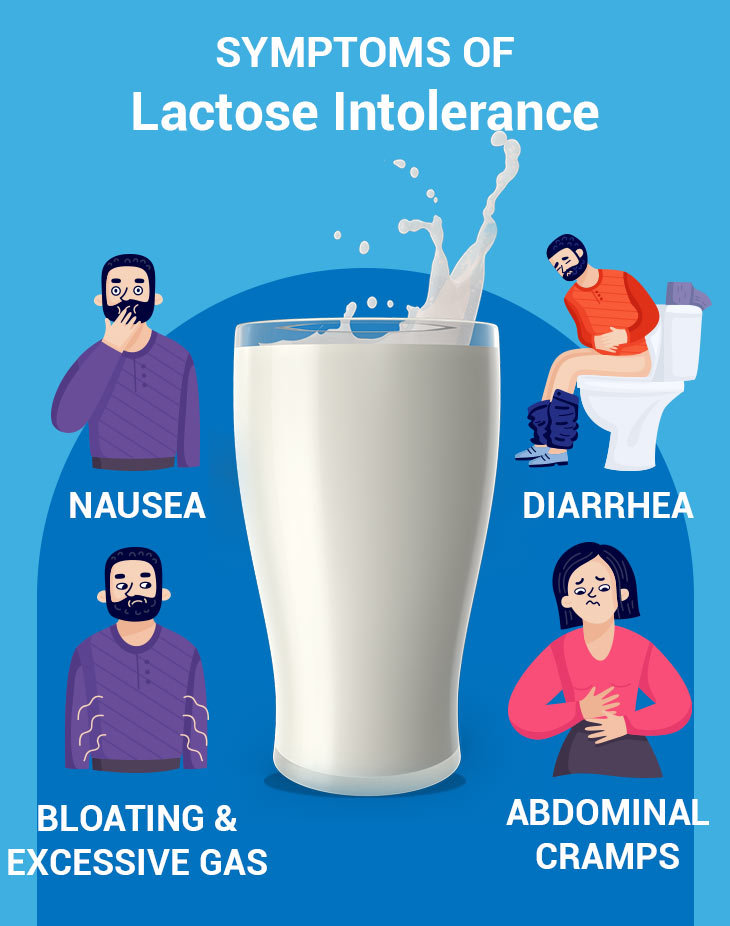
The intensity of these symptoms depends on the severity of your lactose intolerance and the type of dairy products you recently consumed.
What causes lactose intolerance?
We can sort lactose intolerance into three groups: primary lactose intolerance, secondary lactose intolerance and congenital lactose intolerance.
Primary lactose intolerance
This is the most widespread type of lactose intolerance. Most people are born with enough lactase because babies consume their mothers’ milk and need to digest lactose. But as they grow up, they slowly but surely replace milk with other non-dairy foods. Eventually, their level of lactase decreases—usually to a normal level that still allows their bodies to digest lactose properly.
But in some cases, the level decreases too much or the body stops producing the enzyme altogether. Then lactose intolerance takes place. It’s still unclear why the level of lactase sometimes drops too low.
Secondary lactose intolerance
This takes place when the small intestine starts producing less lactase due to an illness, surgery or injury that involves this part of the digestive system.
Sometimes, the treatment of underlying issues can improve the production of lactase, thus allowing a person to digest lactose again. However, it might take time and not every case can see such an improvement.
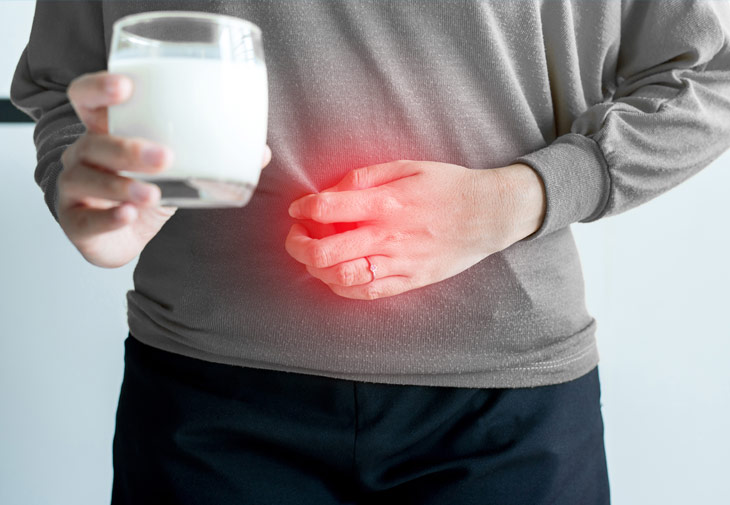
Congenital lactose intolerance
This type of lactose intolerance, also called developmental lactose intolerance, is quite rare and is found in babies from the moment of birth. For a person to have congenital lactose intolerance, they have to get the same variant of a specific gene from both their mother and father. Infants with this type of intolerance can’t digest lactose from the very beginning of their lives due to an insufficient level of lactase.

What can impact the development of lactose intolerance?
While this condition is still very much a mystery in terms of the factors that lead to its development, there are some known causes:
- Age—As we start consuming less dairy and replacing it with other foods, our bodies begin to produce less lactase. Some people’s lactase level becomes critically low between 20 and 40 years old. The reasons for this are still unknown.
- Ethnicity—Research shows that people of African, Hispanic, American Indian and Asian descent develop lactose intolerance more often. This is usually linked to the specific diets these cultures practice. They usually consume less dairy on a daily basis.
- Small intestine diseases and injuries—As we mentioned earlier, secondary lactose intolerance cases are caused by illnesses, surgeries and injuries to the small intestine.
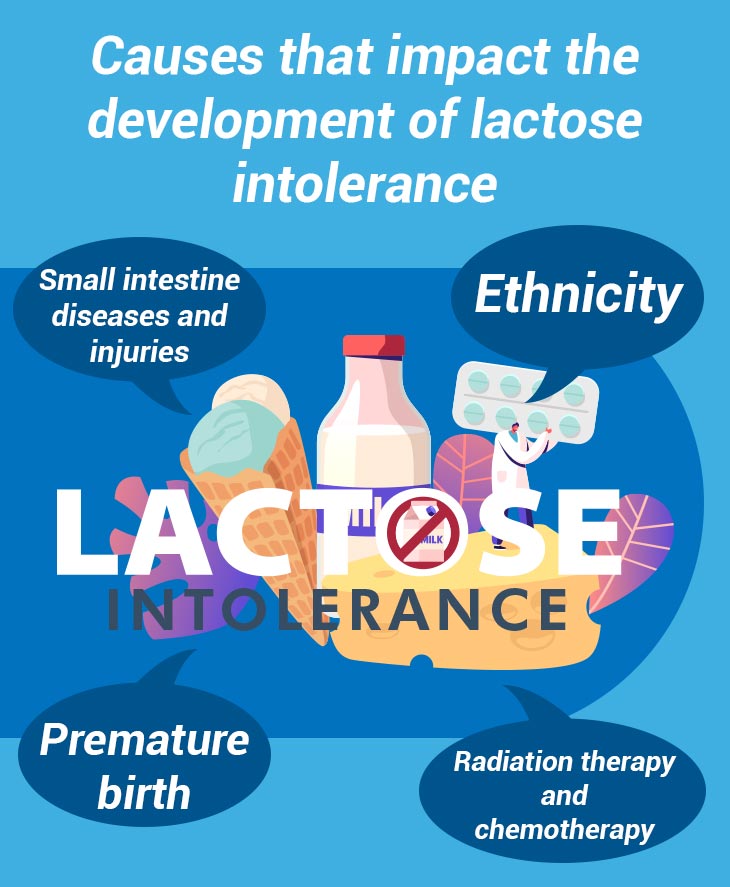
- Premature birth—The small intestine develops lactase-producing cells during the late part of the third trimester of pregnancy. In the case of premature birth, a baby might not have those cells, which will cause lactose intolerance.
- Radiation therapy and chemotherapy—These cancer treatments might put you at risk of developing lactose intolerance.
Is lactose intolerance curable?
In the case of secondary lactose intolerance, the treatment of underlying causes might help the small intestine to produce enough lactase again. But in all other cases, there is no cure.
One solution, however, is lactase pills. They’re usually sold over the counter in pharmacies. You’re supposed to take this pill before consuming any dairy. The lactase will let your body digest lactose properly.
Some people believe that you can “train” your body to tolerate dairy by consuming a progressively larger amount of it over time. They theorize that the small intestine will eventually learn to produce more lactase. This approach isn’t scientifically proven, though. Moreover, the symptoms of lactose intolerance can negatively impact your overall health, as they’re not just uncomfortable but harmful as well.
Complications of lactose intolerance
Dairy products contain a lot of vital vitamins and minerals that support our bones, muscles, digestive and nervous systems, skin and bodies in general. Dairy provides us with calcium, protein and vitamins, such as A, B12 and D. Also, lactose allows our bodies to absorb magnesium, zinc and other vitamins and minerals.
So if you were diagnosed with lactose intolerance or you suspect you might have this condition, consult with your doctor about the supplements you should take to keep yourself healthy and strong.

Another concern is the consequences of lactose intolerance’s symptoms. Diarrhea and vomiting don’t allow our bodies to absorb vital nutrients because we’re getting rid of consumed food before it has a chance to be fully digested. These symptoms can cause dehydration too. That’s why we’re skeptical of eating more dairy to “train” the body to digest it. You might suffer from the symptoms of lactose intolerance all the time, which will lead to malnutrition and perhaps even the development of gastric diseases.
What dairy can you eat if you have lactose intolerance?
Look for lactose-free dairy products. More and more of them are appearing on store shelves around the world. In all likelihood, there’s already a lactose-free version of your favorite dairy—including cheese and ice cream.
Another alternative would be dairy substitutes, such as nut, soy and seed milk as well as products based on them. We wrote an extensive article that dives into all the nutritional differences between animal milk and plant-based milk. If you don’t take taste into consideration, you don’t really lose much in terms of nutrition by replacing animal-derived milk with plant-based options.
Also, some fermented dairy products have little to no lactose and can be safe to consume for individuals with lactose intolerance. Depending on the cultures used to make the product, the fermentation process partially or completely breaks this carbohydrate. For example, Greek yogurt, kefir and some hard cheeses like parmesan are safe for many people who are lactose intolerant.
With that said, you should test dairy products yourself and stay vigilant. Some lactose-intolerant people will feel fine consuming certain cheeses and yogurts, while others will experience symptoms from the same products. It’s different for every individual, so you shouldn’t assume that a dairy product that your lactose-intolerant friend can consume will be just as safe for you.

In the end, lactose intolerance doesn’t mean that you can no longer consume any dairy. You just need to switch to lactose-free versions. And when you can’t resist foods that contain lactose, you can always take a lactase pill to enjoy the taste you love!

